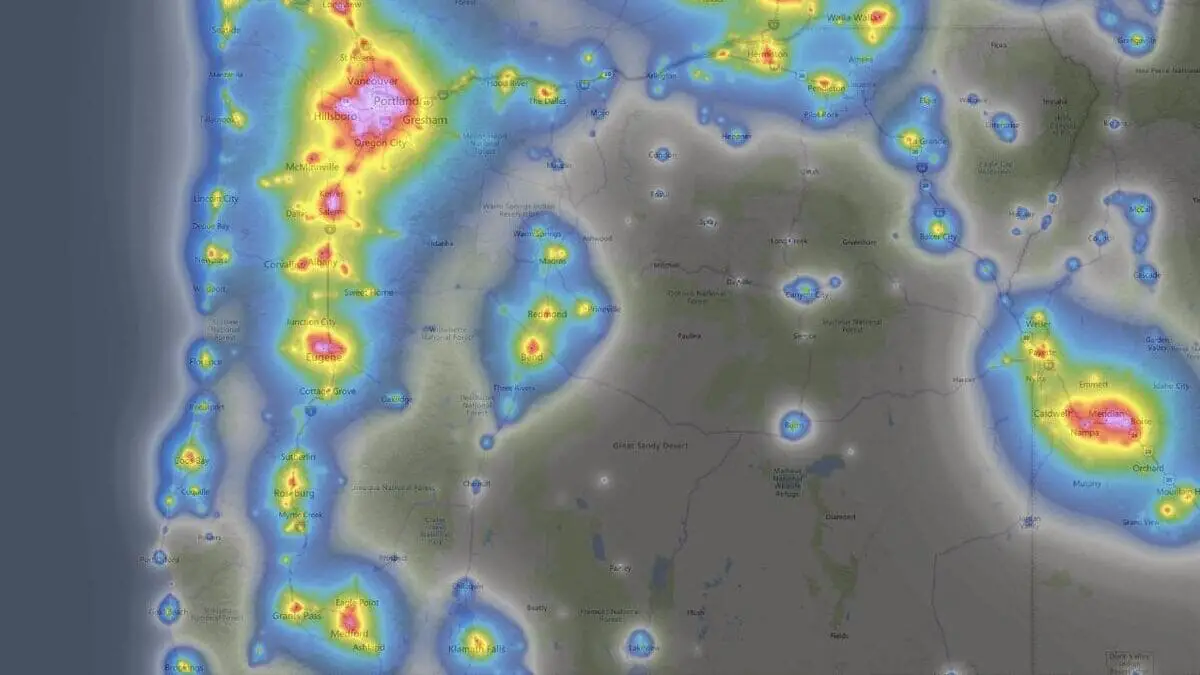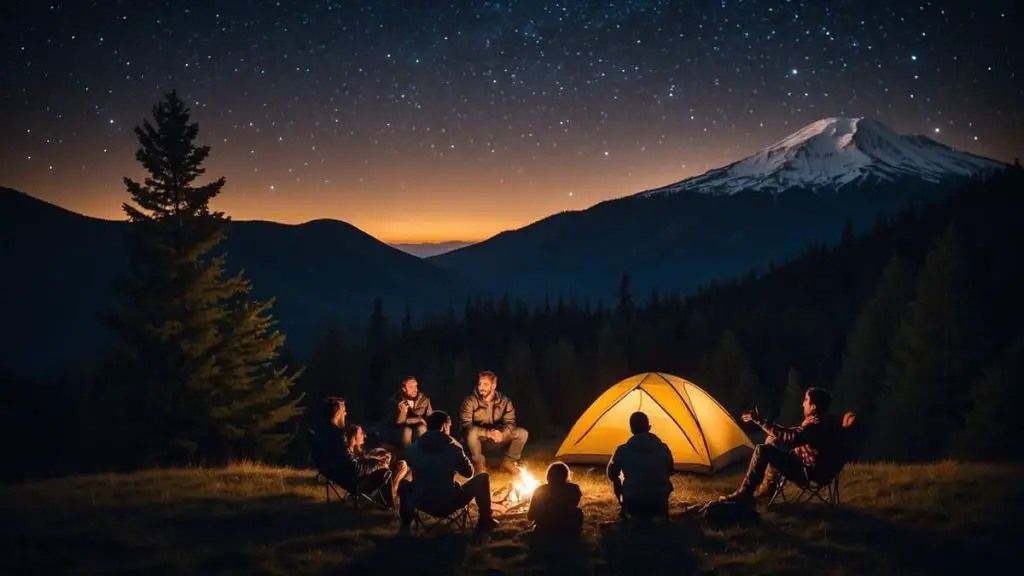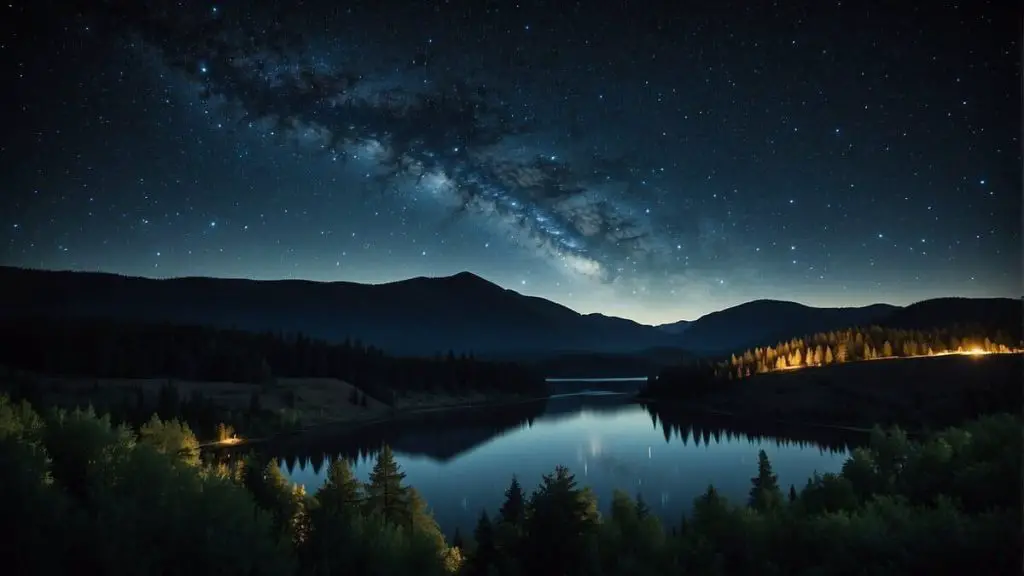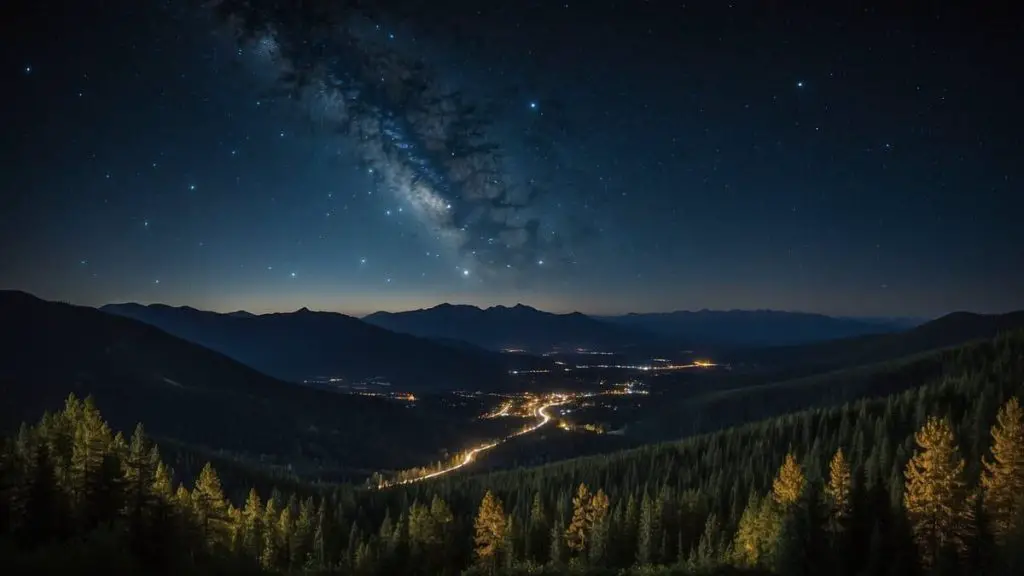You’re passionate about stargazing and eager to explore Oregon’s night skies. Yet, the challenge of light pollution often dims the starry experience.
Light pollution hinders your view of the cosmos, disrupts ecosystems, and wastes energy. This issue can make your quest for the perfect stargazing spot frustrating.
In this article, I guide you through Oregon’s efforts to preserve dark skies. You’ll discover the best locations for stargazing, learn about light pollution reduction, and find resources for an unmatched celestial experience.
Key Things to Know:
- Oregon Dark Sky Map: Use it to find the best stargazing spots with low light pollution.
- Light Pollution Awareness: Learn how reducing artificial light enhances stargazing and helps wildlife.
- Engaging Activities: Explore night hiking, astrophotography, and star parties in Oregon’s dark sky locations.
- Community Efforts: Join initiatives to preserve Oregon’s dark skies.
Recommended For You
Understanding The Oregon Dark Sky Map Initiatives

Oregon is making big moves to keep the night sky dark and full of stars.
In my experience, these efforts have significantly improved the quality of night sky viewing in Oregon. It’s about saying no to too much light at night and yes to amazing starry views.
Let’s dig into what’s being done.
International Dark-Sky Association Role
The International Dark-Sky Association (IDA) is like a star’s best friend. They work hard to stop light pollution from hiding the stars. In Oregon, the IDA helps people understand why dark skies matter.
Their role includes:
- Teaching about the harm of light pollution
- Sharing ways to keep the skies dark at night
Certification of Dark Sky Places
Getting a place certified as a dark sky haven is a big deal. I’ve seen the rigorous efforts places undergo to achieve this esteemed status. The IDA looks at how dark and starry a place is and how hard it’s working to stay that way.
In Oregon:
- Some places have already been certified because they’re awesome for stargazing.
- Others are trying to get this particular star-friendly title.
Stewardship and Protection Efforts
It’s not just about getting a dark sky title; it’s about keeping it that way.
Here’s what’s happening:
- Groups and folks in Oregon are making sure laws are in place to protect the night sky.
- They’re checking light pollution maps and making plans to reduce light that’s not needed.
Everyone can enjoy Oregon’s dark sky wonders for years by controlling light pollution.
Best Stargazing Locations in Oregon

Oregon offers an impressive array of night sky viewing spots, from officially designated Dark Sky Parks to the isolated stretches of the high desert.
State Parks with Dark Sky Designation
Having visited State Parks with Dark Sky Designation, I can attest to their stunning night sky views.
- Prineville Reservoir State Park: Situated in Central Oregon, this park is celebrated for its dark skies. Just lay down a blanket, look up, and enjoy the stars.
- Cottonwood Canyon State Park: Nestled along the John Day River, stargazers can find pristine night skies away from city lights.
High Desert and Remote Areas
- Alvord Desert: Near Steens Mountain, it’s a stargazing haven due to the exceptionally low light pollution.
- Oregon Outback: The wide-open spaces here mean uninterrupted sky views. Remember to let your eyes adjust to the dark for the best experience.
Forest Reserves with Low Light Pollution
- Deschutes National Forest: Just a short drive from Bend, the skies provide a breathtaking backdrop for the Milky Way.
- Rogue River-Siskiyou National Forest: With towering trees framing the night sky, it’s a beautiful spot for observing constellations.
Remember, while stargazing, to give your eyes time to adapt to the dark. This will allow you to see more stars and enjoy the beauty of Oregon’s night sky.
Read my separate article on more Amazing Oregon Stargazing spots, which includes a free Google Map to help plan your adventure!

FREE STARGAZING CHECKLIST
My 5-page Stargazing Checklist will enhance your astronomical observations.
Follow this free checklist to navigate the night sky with confidence, clarity, and a sense of preparedness for a rewarding stargazing experience.

Recreational Activities Under the Stars

When you explore Oregon at night, you can do more than gaze at the stars. There’s camping where you can sleep under the stars, trails for nighttime adventures, and even special gatherings for anyone who loves the night sky.
Camping and Accommodations
You can pitch your tent or park your RV at Prineville Reservoir, where the sky is so clear that you’ll want to stay awake all night. Or, if you prefer a cozy bed, check out the cabins that offer comfort with your stargazing.
Camping options:
- Tented campsites
- RV sites with hookups
- Cabins for a more home-like feel
Hiking, Biking, and Wildlife Watching
Night hikes and bike rides can lead you to hidden spots where the stars shine brightest. Watch for wildlife that comes out at night, too. Just ensure you have your lights and stay on the trails for safety.
Activities after dark:
- I always follow marked trails for hiking, ensuring safe and enjoyable starry adventures.
- Use a red flashlight to keep your night vision sharp.
Astrophotography and Star Parties
Grab your camera and join an astronomy club for a star party. These gatherings are fantastic for learning and sharing astrophotography tips. These groups often welcome newbies. They’ll show you the ropes of astrophotography so you can capture the magic of the Oregon night sky.
Tips for night sky photography:
- Find a dark spot on the Oregon Dark Sky Map
- Join a star party to learn from seasoned astronomers
Minimizing Light Pollution

Light pollution is a problem that affects our view of the stars, but you can take steps to reduce it. Here’s what you need to know.
Community Awareness and Action
Awareness is key. When your community knows about the effects of artificial light at night, it’s easier to make changes.
You can:
- Talk to your neighbors about the benefits of a dark sky.
- Join groups like DarkSky Oregon, which works to protect our night skies.
Responsible Outdoor Lighting
Using outdoor lights wisely helps reduce light pollution.
Do this by:
- Pointing lights downward so they don’t shine up into the sky.
- Choosing lights that are no brighter than necessary.
- Turn off lights when not needed, like when the moon is bright.
Legislation and Dark Sky Compliance
Laws can help keep the skies dark.
Here’s what’s happening:
- Some places have rules to limit artificial light.
- Look for “dark sky” sanctuaries that follow strict lighting rules.
- You can ask local leaders to support dark sky legislation.
Remember, reducing light pollution is something you can help with. Together, we can enjoy the stars without too much artificial light getting in the way.
Navigational Resources and Educational Tools
Exploring Oregon’s night skies requires the right tools and knowledge. I’ll guide you through maps and apps, local clubs and events, and educational programs illuminating the wonders overhead.
Dark Sky Maps and Apps
To start your stargazing adventure, you need a map that shows where the skies are darkest. This approach has led me to some of Oregon’s most spectacular stargazing locations.
Here are some tools to help you:
- Interactive Dark Sky Maps: Find areas with low light pollution to view stars in all their glory.
- Mobile Apps: Download apps that provide real-time info on night sky conditions.
Oregon offers prime spots like Crater Lake and Prineville Reservoir, known for their dark skies and stunning views of the Milky Way.
Local Astronomy Clubs and Events
Get involved with those who share your interest in the cosmos:
- Astronomy Clubs: Join an astronomy club for star parties and tips on the best viewing spots.
- Star Parties: Attend events for group observations; they’re great during the Perseid meteor shower in August.
Local clubs often host events focused on eclipses and visible planet alignments you won’t miss.
Educational Programs at Parks
Parks offer programs that make astronomy fun and accessible:
- Ranger Talks: Learn fascinating facts about the moon, planets, and stars.
- Planetarium shows: Get a simulated tour of the cosmos from professionals.
At Crater Lake National Park, you can often find programs tailored to astronomical events.
Preserving Nighttime Ecology and Astronomy

The beauty and integrity of nighttime in Oregon are safeguarded by various initiatives focused on protecting dark skies. This supports both the natural nighttime ecology and the interests of astronomy enthusiasts.
International Dark Sky Reserves and Sanctuaries
Oregon is part of a global effort to maintain dark skies. The International Dark-Sky Association recognizes places like dark sky reserves and sanctuaries.
Your chances of seeing the Milky Way are great in these particular spots:
- Prineville Reservoir: A recognized Dark Sky Park.
- Oregon Outback: Prime location for an International Dark Sky Sanctuary.
Wildlife Habitats and Natural Skies
Dark nights are crucial for the wildlife habitats in Oregon. Natural skies are a part of life for animals like eagles and pronghorn.
Here’s how dark skies help:
- Reduces confusion during migration and foraging.
- Supports natural behaviors crucial for ecosystem health.
Public Engagement and Events
You’ve got unique opportunities to engage with the stars in Oregon. State parks and forests offer events for you to learn and enjoy the night sky:
- Attend stargazing events at state parks.
- Participate in educational programs about constellations and wildlife watching.
By visiting these areas, you contribute to tourism that values preserving the natural night and learning about our universe.
Planning Your Visit

When you’re gearing up for a night under the stars in Oregon, there are a few key details to remember. I’ll guide you through travel tips, places to stay, and essential safety measures to ensure your stargazing adventure is as stellar as the night sky.
Travel Tips and Best Times to Visit
- Aim for clear, moonless nights; these provide the best stargazing experiences.
- Summer and fall tend to have clearer skies in Oregon. However, some spots at higher elevations, like the Cascade Mountains, can be good year-round, weather permitting.
Accommodations and Amenities
- Camping is popular at Wallowa Lake State Park and Prineville Reservoir, with options for RV sites.
- Looking for comfort? Consider a cabin rental in Central Oregon or near the Coast.
- Most parks have basic amenities, but places like Sunriver and Bend offer restaurants and stores.
Safety and Guidelines
- Always pack the ten essentials for outdoor activities, regardless of the length of your trip.
- Check for cell service; it can be spotty in remote areas like Warner Valley or near Drake Peak Lookout.
- Follow the rules set by Oregon State Parks and DarkSky International—they’re there to protect you and the environment.
- If stargazing is your main activity, bring a telescope if you have one, and remember that some areas, like Hart Mountain National Antelope Refuge, have specific guidelines to conserve the dark sky.
Remember, whether you’re by the serene Oregon Coast or nestled in the majestic Cascade Mountains, staying informed and prepared will help you have an unforgettable stargazing trip.
Frequently Asked Questions

Can I still enjoy stargazing in Oregon’s urban areas?
Yes, you can enjoy stargazing in Oregon’s urban areas, though the experience differs from remote locations. Cities like Portland have parks and observatories offering guided stargazing sessions, ideal for urban astronomers.
Are there any specific times of the year best for stargazing in Oregon?
The best times for stargazing in Oregon are during the dry summer and early fall. These periods typically offer clearer skies, especially in remote areas like the high desert, providing optimal conditions for night sky observation.
How can I participate in preserving Oregon’s dark skies?
You can help preserve Oregon’s dark skies by being a responsible light user, advocating for dark sky-friendly lighting in your community, and supporting local dark sky initiatives. Participation in awareness programs and community events also contributes to these conservation efforts.
TL;DR
- Oregon’s Dark Sky Initiatives focus on reducing light pollution for better stargazing and ecological health.
- The International Dark-Sky Association (IDA) plays a crucial role in certifying and preserving dark sky locations in Oregon.
- Top stargazing spots include Prineville Reservoir, Cottonwood Canyon State Park, Alvord Desert, and national forests like Deschutes and Rogue River-Siskiyou.
- Engage in night activities like camping, hiking, wildlife watching, and astrophotography in Oregon’s dark sky areas.
- Community involvement is crucial through responsible lighting, supporting dark sky legislation, and participating in educational programs.
Your insights and questions are invaluable to me! I’d love to hear your thoughts or answer any queries you might have about Oregon’s dark skies.
Share your experiences or ask away in the comments below!




